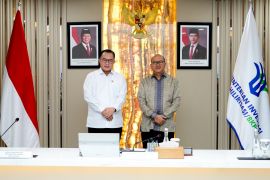Support for researchers is important for product developmentJakarta (ANTARA) - The National Research and Innovation Agency (BRIN) will continue to develop tools and technology to tackle the surge in positive cases of COVID-19 while reducing the use of imported products to handle COVID-19.
"This has been our concern since the start of the pandemic, as various methods and technologies are used for sterilization as well as infections were circulating in the community," Head of the Electronics and Telecommunications Research Organization of BRIN, Budi Prawira, stated during a webinar titled "BRIN Technology Innovation in Facing The surge in COVID-19" in Jakarta, Wednesday.
Prawira noted that the COVID-19 pandemic, which struck over two years back across the country, has had a major impact on human health and resulted in several major losses in all human activities, especially in the economic sector.
The government imposed community activity restrictions (PPKM) and implemented work from home (WFH) regulations to suppress virus transmission. Unfortunately, the restrictions were not supported by adequate high-level technology, Prawira remarked.
This encourages BRIN researchers to develop various innovations through different methods and technologies of sterilization and disinfection to kill the SARS-CoV-2 virus that causes COVID-19 in order to help the public in conducting daily activities, he added.
These include ventilators and health detection devices to cut Indonesia's dependence in foreign products. BRIN also develops a technology that utilizes type C Ultraviolet light (UVC), Prawira stated.
He explained that UVC had a function to kill viruses and bacteria pathogens in the air without harming humans. This technology could be used in all public spaces at an affordable price.
The innovation was made since at the start of the pandemic, several technologies for sterilization in hospitals used UVC 254 nano meters (nm) for sterilizing medical devices. However, at that wavelength, UVC rays were not safe when exposed directly to humans since they caused irritation to the eyes or skin on the long term.
"Hence, we decided to develop Far-UVC, with a wavelength of 222 nm. Despite limitations in its use, namely, the new technology, the price may be relatively higher for (the technology at a wavelength of) 254 nm, but the concern was to create a safe product to kill SARS-CoV-2," he explained.
Prawira ensured that all BRIN researchers will continue to work hard to meet the community's needs during the pandemic, either by creating innovations or developing works in collaboration with researchers from other organizations and experts in their respective fields.
"Support for researchers is important for product development. All of our efforts are made to support government programs to meet the needs of domestic medical device products, especially medical devices, with high technology content," he concluded.
Related news: Need funding flexibility to shore up pandemic surveillance: BRIN
Related news: G20 research collaboration vital for boosting pandemic handling: BRIN
Related news: Govt steps ups supervision of medical device imports, exports
Translator: Hreeloita Dharma S, Resinta S
Editor: Sri Haryati
Copyright © ANTARA 2022












